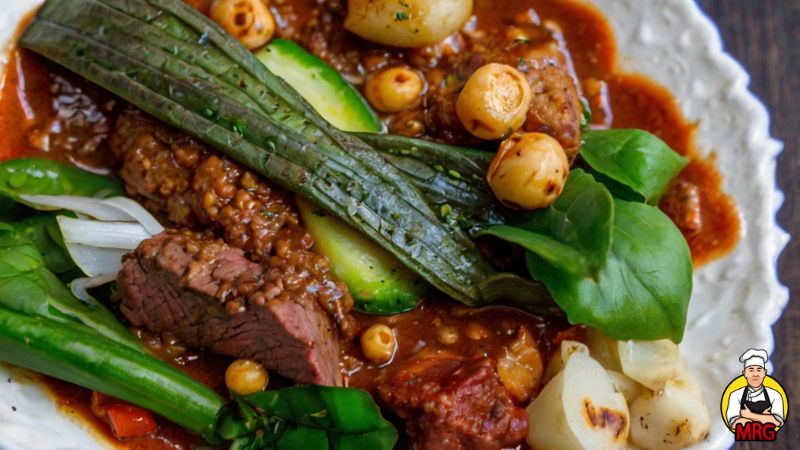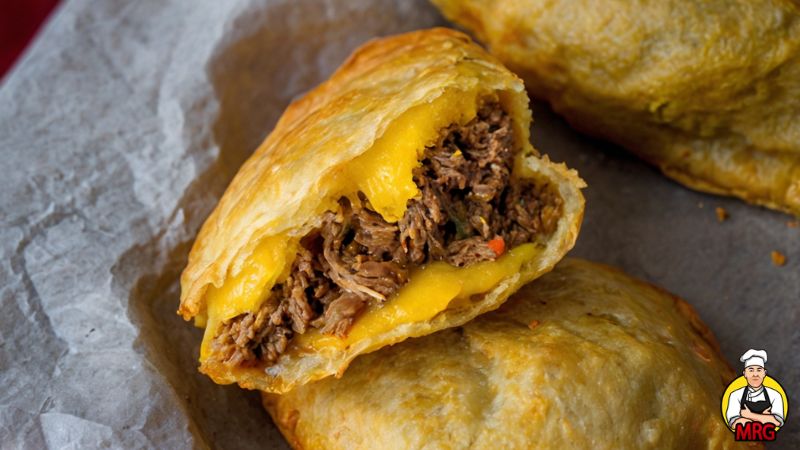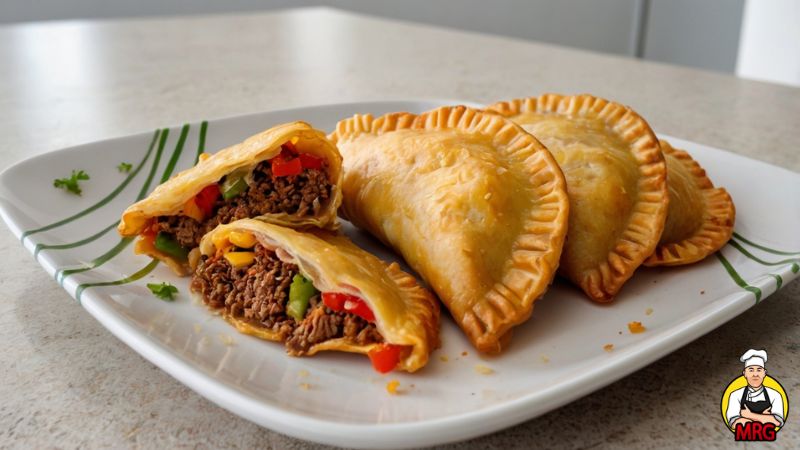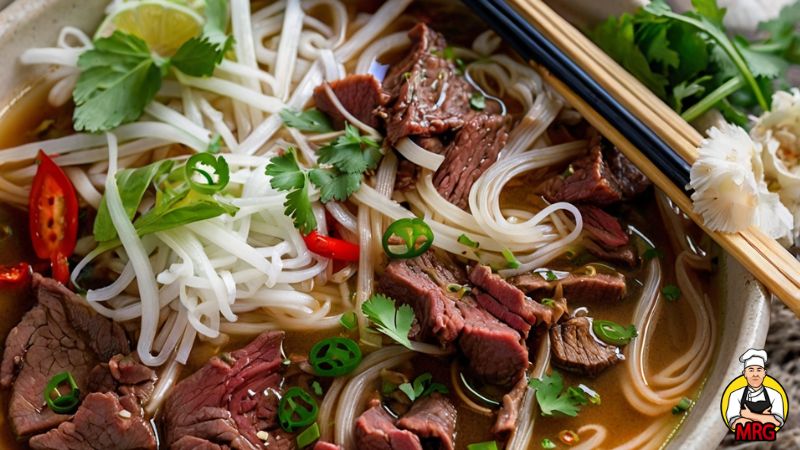Beef Pochero is a beloved Filipino dish, a hearty stew that brings comfort and satisfaction with every bite. This dish, with its rich flavors and tender beef, is perfect for family gatherings and special occasions. Imagine the savory beef mingling with chorizo, potato, and tomato sauce, creating a medley of flavors that warms the soul.
Why I Love Beef Pochero
I adore Beef Pochero for its robust and comforting taste. The combination of tender beef, savory chorizo, and the unique blend of vegetables like bok choy, cabbage, and plantains makes every bite a delightful experience. This dish is perfect for Sunday family lunches or festive gatherings. It’s a meal that brings everyone together, filling the house with a mouthwatering aroma that promises a delicious feast.
Choosing the Right Main Ingredients
What Makes the Perfect Beef for Pochero?
Selecting the right beef is crucial for a successful Pochero. Opt for cuts like brisket or chuck roast, which are ideal for slow-cooking and become tender and flavorful. Look for meat that has a good amount of marbling, as the fat will render down and add richness to the stew. Quality beef ensures a melt-in-your-mouth experience.
Seasoning the Pochero: What’s Essential?
How Do You Get the Seasoning Just Right?
Seasoning is key to a flavorful Beef Pochero. Start with basic seasonings like salt and pepper, but don’t forget the essential fish sauce for that umami kick. Adding chorizo infuses the dish with a smoky, savory flavor that complements the beef perfectly. Garlic, onion, and bay leaves are also fundamental, enhancing the depth of the stew.
Recommended Cooking Equipment
What Tools Will Make Your Cooking Easier?
- Pressure Cooker: Speeds up the cooking process, ensuring your beef is tender in less time.
- Heavy-bottomed Pot: Ideal for even heat distribution, preventing burning.
- Sharp Knife: Essential for prepping your ingredients efficiently.
- Wooden Spoon: For stirring without scratching your pots.
Using these tools effectively makes the cooking process smoother and more enjoyable. A pressure cooker, in particular, is a game-changer, cutting down the cooking time while ensuring your beef is perfectly tender.
Beef Pochero Recipe
Filipino Beef Pochero
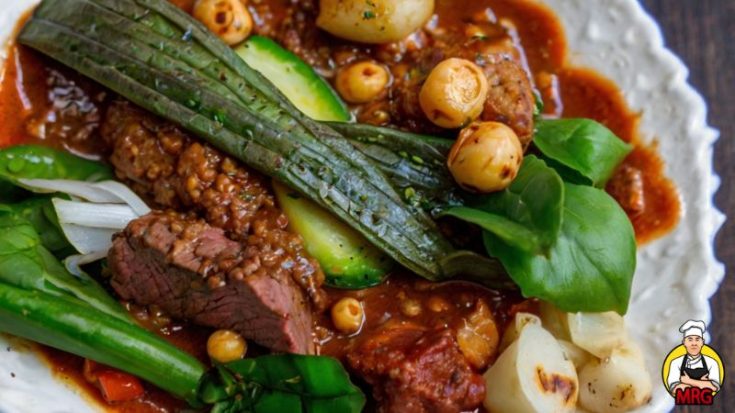
Beef Pochero recipe is a dish close to my heart, embodying the warmth and generosity of Filipino culture. Its rich, savory flavors and hearty ingredients make every spoonful a comforting embrace, perfect for bringing family and friends together. Each bite takes me on a nostalgic journey, reminding me of festive gatherings and shared joy.
Ingredients
- 1.5 pounds of beef brisket, cut into chunks
- 2 tablespoons cooking oil
- 4 cloves garlic, minced
- 1 large onion, sliced
- 3 ripe tomatoes, chopped
- 1/4 cup fish sauce
- 6 cups water
- 1 cup tomato sauce
- 2 large potatoes, peeled and quartered
- 2 plantains, sliced into rounds
- 1 cup garbanzos (chickpeas), canned and drained
- 1 bunch bok choy, trimmed
- 1 small head of cabbage, quartered
- 1/2 pound long green beans, halved
- 2 pieces chorizo, sliced (optional)
- Salt and pepper to taste
Instructions
- Heat the Oil: In a pressure cooker, heat the oil over medium heat. Add the garlic, onion, and tomatoes, and sauté until the onions are translucent and tomatoes release their juices.
- Sear the Beef: Add the beef chunks to the pot and fry until all sides are browned. Pour in the fish sauce and cook for another 2 minutes.
- Add Liquids: Pour in water and tomato sauce, stirring to combine. Close the pressure cooker lid securely and bring to high pressure. Cook for 30 minutes.
- Release Pressure: After 30 minutes, turn off the heat and allow the pressure to release naturally.
- Add Vegetables: Once the pressure is released, open the lid and add potatoes, plantains, and chorizo. Close the lid again and cook under high pressure for another 10 minutes.
- Final Vegetables: Release the pressure, then add garbanzos, bok choy, cabbage, and green beans. Simmer uncovered for 5-10 minutes, or until the vegetables are tender.
- Season: Adjust salt and pepper to taste. Stir gently to combine without breaking the vegetables.
Nutrition Information:
Yield:
6Serving Size:
1Amount Per Serving: Calories: 380Total Fat: 12gSodium: 1100mgCarbohydrates: 40gFiber: 6gProtein: 35g
Serving Suggestions and Suitable Side Dishes:
Beef pochero is best served hot, with steamed rice on the side to soak up the savory sauce. For a complete meal, pair it with a simple cucumber salad or pickled papaya to add a refreshing contrast to the hearty stew.
Cooking Tips and Common Mistakes to Avoid:
- Avoid Overcrowding: When searing the beef, do it in batches if necessary. Overcrowding the pan can cause the meat to steam instead of sear, resulting in less flavor.
- Mind the Cooking Time: Pay close attention to the cooking times, especially for vegetables. Overcooking can make them mushy.
- Natural Release is Crucial: Always allow the pressure to release naturally to ensure that the meat remains tender and the flavors are well-developed.
Conclusion:
Beef pochero is not just a dish; it’s a flavorful journey through Filipino culinary traditions, bringing families together around the table. By following these detailed steps and tips, you can master this delightful stew and impress your loved ones with a taste of the Philippines.
This comprehensive guide to making beef pochero ensures that even a novice cook can produce a flavorful and satisfying meal, proving that great cooking is about simplicity and respect for the ingredients. Enjoy the process, and savor the results!
Related Article:
I’m Calvin Lamb, an LA-based culinary enthusiast with a decade’s experience in five-star kitchens. My innovative dishes, inspired by seasonal flavors and sustainable practices, blend classic and modern cuisine. Besides crafting unique culinary experiences, I relish exploring new eateries and devising fresh recipes.
